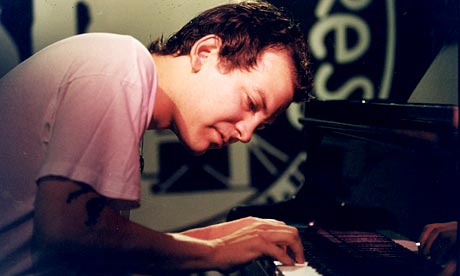Download the Transcription: Piano Score + Bass
Audio Link: August Ending
“August Ending” Brad Mehldau
For nearly two decades, composer-improvisor Brad Mehldau has left a prophetic mark on the music of our generation. One supporting reason is that his music strikes an emotional, spontaneous core while maintaining a structural quality evident through analysis. House on Hill was released by the Brad Mehldau trio (Rossy on drums) in 2006, and the opening track, “August Ending,” illustrates Mehldau’s search for “successful integration of composed and improvised material.”1 Feel free to decide for yourself, but I’m pretty convinced he’s on the right track.
The composition is bound together by a string of 8th notes (A-Bb), which while fitting colorfully into the harmony serve several foundational purposes throughout the tune. First and foremost, they tie each phrase/section together, an important task given the slow harmonic rhythm. Brad does well to syncopate his articulation, preventing any dulling effect and keeping his phrases afloat (let’s just say he’s very patient). Next, these 8th notes introduce us to an essential interval in the composition: the minor 2nd, which pervades both melody and accompaniment (ex: m.11, 20-21, 56-57) . Finally, these 8th notes set the affective tone for the entire tune, perhaps the whole album. Choose your own associations, but when I hear an endless stream of medium-fast 8th notes over a minor 2nd, I am not lulled into a warm vernal reverie, nor am I provoked to get on my bike and enjoy the floral aroma of spring.
But enough with programatic musings: this tune rocks. Here are some more reasons why.
Ever the master of counterpoint, Brad has clearly defined 4 voices in the piano alone by the time we hear the melody. Each plays a specific roll, the ‘baritone’ as a countermelody (heard first as D- F-E in the left hand), tenor as chordal accompaniment (same minor 2nd but an octave below), alto (8th notes) as our driving rhythm, and for now the soprano gets the ‘song,’ albeit a rather un-virtuosic one. Each voice is brought out exquisitely and independently, a quality that can be observed in Brad’s solo in addition to the head.
http://www.bradmehldau.com/writing/papers/house_hill.html
If you haven’t checked out Brad’s website, and more specifically his collection of personal essays/articles (found in writing), it is worthy of inspection, especially for those who need to understand what gives his music its authority.
The overarching structure of “August Ending” contributes to the piece’s success. Each A of the AABA1 form is comprised of a long circle of 4ths, marked by dorian modality (ii-V7’s) and deceptive resolutions that bring us around to the ambiguous key of Gm7-C7. In the bridge, however, Brad stretches the versatility of the A-Bb motive to a new degree. Moving the 8th notes down an octave gives the B section a revitalized sense of perpetual motion, and Brad’s other-worldly harmonic development makes you forget all about the diatonic ii-V landscape that came before. What other chord does A-Bb fit into tastefully? E half diminished, of course! From there continues a colorful sequence of step-wise ascending roots under shifting inversions and extensions (B-Maj7Add natural7!), all under a melody that achieves a spoken simplicity despite its indirect relationship to the passing harmony.
The harmonic density of the bridge allows for a sense of repose in measure 59, when Brad opens up the ongoing 8th notes into a consonant perfect 4th, returns to a diatonic, two-chord pattern similar to that of the A sections (but with a fresh Maj7 twist). Using a variation on the opening melodic motive, Brad oscillates between the original circle-of-fourths and the modal mixture of the development to bring close the head in the parallel key(s) of G7-C7.
Next comes Brad’s chorus-and-1⁄2 solo: crisp, succinct, poetic. Upon looking more closely I was reminded of my first transcription, that of Wynton Kelly’s solo on “Freedy Freeloader.” I was blown away by the coherence of Wynton’s improvisation, his ability to develop several ideas throughout multiple choruses, returning to each one with subtle evolutions. Brad accomplishes the same feat, developing material derived from the head (ex. scalar G-A-Bb-C—Db-C-Bb-D, mm.93-108) with a sense of space that I’ve come to expect and appreciate in his playing.
The solo continues and transforms; Brad maintains the textural contrast between A and B, incorporating a double time right hand-left hand dialogue that capitalizes on the full range of the piano (mm.130-140). With a rich language unique to him, Brad weaves his way through the form, punctuating the end of his solo with a bluesy flourish in measures 192-195. The expressive range of Brad’s improvisation creates a sense of homecoming as the A-Bb 8th note theme returns. Melody plays out, and the piece gradually thins in texture until we are left with the same undulating 8th notes that greeted us to start.
Give “August Ending” several listens; with October leaves in full transition, House on Hill makes for quite a narrative.
